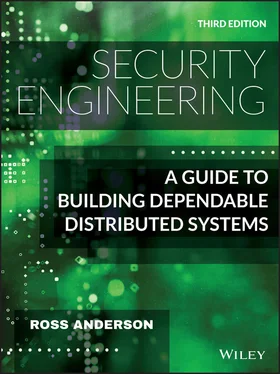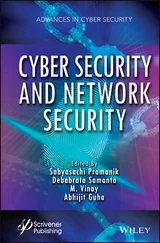Ross Anderson - Security Engineering
Здесь есть возможность читать онлайн «Ross Anderson - Security Engineering» — ознакомительный отрывок электронной книги совершенно бесплатно, а после прочтения отрывка купить полную версию. В некоторых случаях можно слушать аудио, скачать через торрент в формате fb2 и присутствует краткое содержание. Жанр: unrecognised, на английском языке. Описание произведения, (предисловие) а так же отзывы посетителей доступны на портале библиотеки ЛибКат.
- Название:Security Engineering
- Автор:
- Жанр:
- Год:неизвестен
- ISBN:нет данных
- Рейтинг книги:3 / 5. Голосов: 1
-
Избранное:Добавить в избранное
- Отзывы:
-
Ваша оценка:
Security Engineering: краткое содержание, описание и аннотация
Предлагаем к чтению аннотацию, описание, краткое содержание или предисловие (зависит от того, что написал сам автор книги «Security Engineering»). Если вы не нашли необходимую информацию о книге — напишите в комментариях, мы постараемся отыскать её.
secure? Understand how to engineer dependable systems with this newly updated classic
In
Cambridge University professor Ross Anderson updates his classic textbook and teaches readers how to design, implement, and test systems to withstand both error and attack.
This book became a best-seller in 2001 and helped establish the discipline of security engineering. By the second edition in 2008, underground dark markets had let the bad guys specialize and scale up; attacks were increasingly on users rather than on technology. The book repeated its success by showing how security engineers can focus on usability.
Now the third edition brings it up to date for 2020. As people now go online from phones more than laptops, most servers are in the cloud, online advertising drives the Internet and social networks have taken over much human interaction, many patterns of crime and abuse are the same, but the methods have evolved. Ross Anderson explores what security engineering means in 2020, including:
How the basic elements of cryptography, protocols, and access control translate to the new world of phones, cloud services, social media and the Internet of Things Who the attackers are – from nation states and business competitors through criminal gangs to stalkers and playground bullies What they do – from phishing and carding through SIM swapping and software exploits to DDoS and fake news Security psychology, from privacy through ease-of-use to deception The economics of security and dependability – why companies build vulnerable systems and governments look the other way How dozens of industries went online – well or badly <l

 we can easily compute the hash value
we can easily compute the hash value  , but it is very difficult given
, but it is very difficult given  to find
to find  if such an input is not already known. (The elf will only pick outputs for given inputs, not the other way round.) As the output is random, the best an attacker can do to invert a random function is to keep on feeding in more inputs until he gets lucky; with an
if such an input is not already known. (The elf will only pick outputs for given inputs, not the other way round.) As the output is random, the best an attacker can do to invert a random function is to keep on feeding in more inputs until he gets lucky; with an  -bit output this will take about
-bit output this will take about  guesses on average. A pseudorandom function will have the same properties, or they could be used to distinguish it from a random function, contrary to our definition. So a pseudorandom function will also be a one-way function , provided there are too many possible outputs for the opponent to guess an input that has a desired target output by chance. This means choosing
guesses on average. A pseudorandom function will have the same properties, or they could be used to distinguish it from a random function, contrary to our definition. So a pseudorandom function will also be a one-way function , provided there are too many possible outputs for the opponent to guess an input that has a desired target output by chance. This means choosing  so that the opponent can't do anything near
so that the opponent can't do anything near  computations. If we claim, for example, that SHA256 is a pseudorandom function, then we're saying that there's no practical way to find an input that hashes to a given 256-bit value, unless you knew it already and used it to compute that value.
computations. If we claim, for example, that SHA256 is a pseudorandom function, then we're saying that there's no practical way to find an input that hashes to a given 256-bit value, unless you knew it already and used it to compute that value. by concatenating it with a secret key
by concatenating it with a secret key  and computing
and computing  . If the hash function isn't random enough, though, using it for one-way encryption in this manner is asking for trouble. (I'll discuss an example later in section 22.3.1: the hash function used by many phone companies in the 1990s and early 2000s to authenticate mobile phone users wasn't random enough, which led to attacks.)
. If the hash function isn't random enough, though, using it for one-way encryption in this manner is asking for trouble. (I'll discuss an example later in section 22.3.1: the hash function used by many phone companies in the 1990s and early 2000s to authenticate mobile phone users wasn't random enough, which led to attacks.) with
with  . Unless the opponent can find a shortcut attack (which would mean the function wasn't pseudorandom) then the best way of finding a collision is to collect a large set of messages
. Unless the opponent can find a shortcut attack (which would mean the function wasn't pseudorandom) then the best way of finding a collision is to collect a large set of messages  and their corresponding hashes
and their corresponding hashes  , sort the hashes, and look for a match. If the hash function output is an
, sort the hashes, and look for a match. If the hash function output is an  -bit number, so that there are
-bit number, so that there are  possible hash values, then the number of hashes the enemy will need to compute before he can expect to find a match will be about the square root of this, namely
possible hash values, then the number of hashes the enemy will need to compute before he can expect to find a match will be about the square root of this, namely  hashes. This fact is of huge importance in security engineering, so let's look at it more closely.
hashes. This fact is of huge importance in security engineering, so let's look at it more closely. fish in a lake and you catch
fish in a lake and you catch  of them, ring them and throw them back, then when you first catch a fish you've ringed already,
of them, ring them and throw them back, then when you first catch a fish you've ringed already,  should be ‘about’ the square root of
should be ‘about’ the square root of  . The intuitive reason why this holds is that once you have
. The intuitive reason why this holds is that once you have  samples, each could potentially match any of the others, so the number of possible matches is about
samples, each could potentially match any of the others, so the number of possible matches is about  x
x  or
or  , which is what you need 3.
, which is what you need 3.









